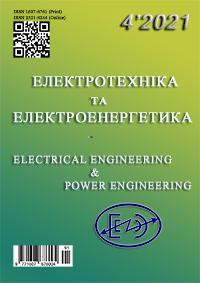Considering the effect of dustiness of a photovoltaic module surfaces on solar power generation by matlab software
DOI:
https://doi.org/10.15588/1607-6761-2021-4-5Keywords:
active power, reactive power, normal distribution, kurtosis, asymmetry, mathematical expectation, deviationAbstract
Purpose. Improving the simulation model of a solar power plant by creating a block model for accounting for dustiness of the surface of photovoltaic modules when calculating the efficiency of electric power generation by a solar power plant.
Methodology. Use of statistical data processing methods and modeling in the structure of Matlab tools.
Findings. A mathematical model was created, which made it possible to take into account the influence of dustiness of the surface of photovoltaic modules on the efficiency of electric power generation by a solar power station. The model was tested on the real object and the accuracy of modeling was proved.
Originality. The scientific novelty is to create mathematical models that describe the effect of dust on the surface of photovoltaic modules on the efficiency of solar station generation based on the Bouguer-Lambert-Behr law, the blocks of precipitation influence on dust were developed, and the rate of dust accumulation was corrected by taking into account the air humidity.
Practical value. The obtained results will help to improve the accuracy of modeling of all types of photovoltaic systems. These models can be used as the formation of commercial proposals with more accurate schedules of electric power generation, which can significantly increase the accuracy of the choice of rated capacity of equipment.
References
Yarmukhametov, U. R., Akhmetshin, A. T. (2014) Imitatsionnoye modelirovaniye rezhimov raboty solnechnykh ustanovok s fotoelektricheskimi preobrazovatelyami v zavisimosti ot vnutrennikh i vneshnikh faktorov v srede Matlab/Simulink. Vest-nik KrasGAU. No 8.
Ivanchura, V. I., Krasnobayev, YU. V., Post, S. S. (2014) Imitatsionnaya model' avtonomnoy sistemy elektropitaniya. Journal of Siberian Federal Univer-sity. Engineering & Technologies.
Shevchenko, S., Danylchenko, D., Dryvetskyi, S., Po-tryvai, A. (2021). Modernization of a Simulation Model of a Photovoltaic Module, by Accounting for the Effect of Snowing of Photovoltaic Panels on Sys-tem Performance with Correction for Panel Cleaning for Matlab Simulink. 2021 IEEE 2nd KhPI Week on Advanced Technology (KhPIWeek), 670-675, DOI: 10.1109/KhPIWeek53812.2021.9570030
Rubanenko, O.O. Danylchenko, D.O. Teptya, V.V. (2020). Opredeleniye generirovaniya VIE s ispol'zovaniyem iskusstvennykh neyronnykh setey. Vestnik Natsional'nogo tekhnicheskogo universiteta "KHPI". Seriya: Energetika: nadezhnost' i ener-goeffektivnost': sb. nauk. pr. Khar'kov: NTU «KHPI», No 1 (1) 2020, 70-77.
Obukhov, S.G., Plotnikov, I.A. (2017). Imitatsionnaya model' rezhimov raboty avtonomnoy fotoelektrich-eskoy stantsii s uchetom real'nykh usloviy eksplu-atatsii Izvestiya Tomskogo politekhnicheskogo uni-versiteta. Inzhiniring georesursov. Vol 328, No 6, 38–51
Liu, B.Y.H., Jordan, R.C. (1961) Daily insolation on surfaces tilted towards the equator. ASHRAE Jour-nal. Vol 3, 53–59.
Duffie, J.A., Beckman, W.A. (2013). Solar Engineering of Thermal Processes. Hoboken, New Jersey, John Wiley & Sons, Inc., 910.
Tremblay, O., Dessaint, L.A., Dekkiche, A.I. (2007) A Generic Battery Model for the Dynamic Simulation of Hybrid Electric Vehicles. Vehicle Power and Pro-pulsion Conference, 284–289.
Khasawneh, A., Mohamed Qawaqzeh, Miroshnyk, О., Danylchenko, D, Minakova, K., Potryvai, А. (2021) Methodology For Accounting For The Influence Of Dust Cover On The Performance Of A Photovoltaic System For Matlab Simulink. 2021 IEEE 20th Inter-na-tional Conference on Mod-ern Electrical and En-ergy Systems (MEES), 1-6, DOI: 10.1109/MEES52427.2021.9598611
Tremblay, O., Dessaint, L.A. (2009) Experimental Validation of a Battery Dynamic Model for EV Ap-plications. World Electric Vehicle Journal, Vol. 3, 1–10.
Kolomiyets, YU.G., Tarasenko, A.B., Tebuyev, V.V., Suleymanov, M.ZH. (2018) Issledovaniye vliyaniya razlichnykh vidov zagryazneniy na effektivnost' ek-spluatatsii solnechnykh energoustanovok // Mezhdu-narodnyy nauchnyy zhurnal «Al'ternativnaya ener-getika i ekologiya» (ISJAEE). 04-06, 12-24.
Danylchenko, D., Minakova, K., Potryvai, A. (2021) Modeling the influence of dustiness of photovoltaic modules on their performance in Matlab / D. Danylchenko, Energy. Series: “Modern problems of power engineering and ways of sloving them”. Geor-gia, Tbilisi, No 2 (98). Vol 1, 126-131.
Kolomiyets, YU.G. (2017) Issledovaniye vliyaniya zateneniya na effektivnost' ekspluatatsii solnech-nykh energoustanovok v usloviyakh plotnoy go-rodskoy zastroyki. Mezhdunarodnyy nauchnyy zhur-nal «Al'ternativnaya energetika i ekologiya» (IS-JAEE). No 19-21, 16-25.
Sarver, T. A (2013) comprehensive review of the im-pact of dust on the use of solar energy: History, in-vestigations, results, literature, and mitigation ap-proaches [Text]. Renewable and Sustainable Energy Reviews, Vol. 22, 698-733.
Goossens, D., Kerschaever, E. Van., (1999) Aeolian dust deposition on photovoltaic solar cells: the ef-fects of wind velocity and airborne dust concentra-tion on cell performance [Text]. Solar Energy, Vol. 66, 277–289.
Shevchenko, S. Dovgalyuk, O., Danylchenko, D., Rubanenko, O., Fedorchuk, S. Potryvai, A. (2021) Accounting For The Effect Of PV Panel Dustiness On System Performance With Correction For Panel Cleaning For Matlab Simulink. 2021 IEEE 3rd Ukraine Conference on Electrical and Computer Engineering (UKRCON), 373-378, DOI: 10.1109/UKRCON53503.2021.9575747
Danylchenko, D. Potryvai, A. (2020) Optimization of accumulation units in a mobile, autonomous cottage settlement as a part of maneuvering system. Energy. Series: “Modern problems of power engineering and ways of sloving them”. Georgia, Tbilisi, No 4 (96). Part 1., 120-123.
Downloads
Published
How to Cite
Issue
Section
License

This work is licensed under a Creative Commons Attribution 4.0 International License.
Creative Commons Licensing Notifications in the Copyright Notices
Authors who publish with this journal agree to the following terms:
Authors retain copyright and grant the journal right of first publication with the work simultaneously licensed under aCreative Commons Attribution License that allows others to share the work with an acknowledgement of the work's authorship and initial publication in this journal.
Authors are able to enter into separate, additional contractual arrangements for the non-exclusive distribution of the journal's published version of the work (e.g., post it to an institutional repository or publish it in a book), with an acknowledgement of its initial publication in this journal.
Authors are permitted and encouraged to post their work online (e.g., in institutional repositories or on their website) prior to and during the submission process, as it can lead to productive exchanges, as well as earlier and greater citation of published work.

